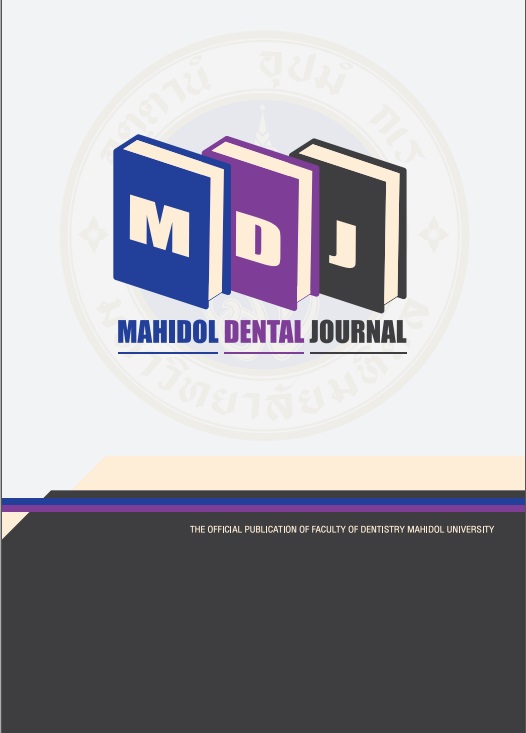A novel negative airflow aerosol chamber minimized aerosol transmission during ultrasonic scaling: A laboratory investigation
Main Article Content
Abstract
Objective: The purpose of this study was to evaluate the effectiveness of a novel negative airflow aerosol chamber in reducing aerosols and droplets during ultrasonic scaling.
Materials and Methods: We created a new protective chamber for minimizing the bioaerosols generated during dental treatment. The negative airflow aerosol chamber comprised a hexagonal-steel frame with a reusable plastic drape connected to an air-purifier to create negative air flow. The effectiveness of the negative airflow aerosol chamber was evaluated using a dental manikin model fixed on a dental chair head rest. Ultrasonic scaling was performed for 10 minutes using an ultrasonic scaler supplied with a L. acidophilus suspension to evaluate the dissemination of dental aerosols generated during scaling with or without the negative airflow aerosol chamber. Culture plates containing De Man, Rogosa, and Sharpe agar were placed at 5 positions in the dental operating room. Scaling was performed and the plates were left exposed for 20 minutes after scaling was completed. The plates were incubated at 37±0.5°C for 48 hours in an anaerobic environment. The bacterial colonies were counted and reported as colony forming units per plate (CFU/plate).
Results: The bacterial colonies were detected at all positions. The negative airflow aerosol chamber significantly decreased the number of bacterial colonies at all sampling sites (p<0.05). Moreover, when using the negative airflow aerosol chamber, the total colonies were reduced by 86.63±9.86%.
Conclusion: The negative airflow aerosol chamber is effective in reducing the dental bioaerosols created during ultrasonic scaling.
Article Details

This work is licensed under a Creative Commons Attribution-NonCommercial-NoDerivatives 4.0 International License.
References
Baseer MA, Rahman G, Yassin MA. Infection control practices in dental school: A patient perspective from Saudi Arabia. Dent Res J (Isfahan) 2013; 10: 25-30.
Akhtar F, Rehman S. A Public Health Analysis on Gaps in Disease Monitoring and Opportunities for Improved Care for the Management of Hepatitis B and C. Cureus 2018; 10: e2077.
Natto ZS, Alshehri MM, Alghamdi FK. Infection Control Practices at the Dental Clinics in Jeddah, Saudi Arabia. J Multidiscip Healthc 2021; 14: 2951-7.
Chuang CY, Cheng HC, Yang S, Fang W, Hung PC, Chuang SY. Investigation of the spreading characteristics of bacterial aerosol contamination during dental scaling treatment. J Dent Sci 2014; 9: 294-6.
Singh A, Shiva Manjunath RG, Singla D, Bhattacharya HS, Sarkar A, Chandra N. Aerosol, a health hazard during ultrasonic scaling: A clinico-microbiological study. Indian J Dent Res 2016; 27: 160-2.
Grenier D. Quantitative analysis of bacterial aerosols in two different dental clinic environments. Appl Environ Microbiol 1995; 61: 3165-8.
Harrel SK, Molinari J. Aerosols and splatter in dentistry: a brief review of the literature and infection control implications. J Am Dent Assoc 2004; 135: 429–37.
Meng L, Hua F. Coronavirus Disease 2019 (COVID-19): Emerging and future challenges for dental and oral medicine. J Dent Res 2020; 99: 481-7.
Bentley CD, Burkhart NW, Crawford JJ. Evaluating spatter and aerosol contamination during dental procedures. J Am Dent Assoc 1994; 125: 579-84.
Harrel SK, Barnes JB, Rivera-Hidalgo F. Aerosol and splatter contamination from the operative site during ultrasonic scaling. J Am Dent Assoc 1998; 129: 1241–9.
Grenier D. Quantitative analysis of bacterial aerosols in two different dental clinic environments. Appl Environ Microbiol 1995; 61: 3165-8.
Innes N, Johnson IG, Al-Yaseen W, Harris R, Jones R, Kc S, et al. A systematic review of droplet and aerosol generation in dentistry. J Dent 2021; 105: 103556.
Sorbello M, Rosenblatt W, Hofmeyr R, Greif R, Urdaneta F. Aerosol boxes and barrier enclosures for airway management in COVID-19 patients: a scoping review and narrative synthesis. Br J Anaesth 2020; 125: 880-94.
Babu B, Gupta S, Sahni V. Aerosol box for dentistry. Br Dent J 2020; 228: 660.
Cook TM, El-Boghdadly K, McGuire B, McNarry AF, Patel A,Higgs A. Consensus guidelines for managing the airway in patients with COVID-19. Anaesthesia 2020; 75: 785-99.
Chen X, Liu Y, Gong Y, Guo X, Zuo M, Li J. et al. Perioperative management of patients infected with the novel coronavirus: recommendation from the joint task force of the Chinese society of anesthesiology and the Chinese association of anesthesiologists. Anesthesiology 2020; 132: 1307-16.
Horsophonphong S, Chestsuttayangkul Y, Surarit S, Lertsooksawat W. Efficacy of extraoral suction devices in aerosol and splatter reduction during ultrasonic scaling: A laboratory investigation. J Dent Res Dent Clin Dent Prospects 2021; 15: 197–202.
Chestsuttayangkul Y, Lertsooksawat W, Horsophonphong S. Efficacy of dental barriers in aerosols and splatters reduction during an ultrasonic scaling: An in-vitro study. J Int Soc Prevent Communit Dent 2022; 12: 71-7.
De Man JC, Rogosa M, Sharpe ME. A medium for the cultivation of lactobacilli. J Appl Bacteriol 1960; 23: 130-5.
Han P, Li H, Walsh LJ, Ivanovski S. Splatters and aerosols contamination in dental aerosol generating procedures. Appl Sci 2021; 11: 1914.
Suprono MS, Won J, Savignano R, Zhong Z, Ahmed A, Roque-Torres G, et al. A clinical investigation of dental evacuation systems in reducing aerosols. J Am Dent Assoc 2021; 152: 455-62.
Du Buy H, Arnold FA, Olson BJ. Studies on the air transmission of micro-organisms derived from the respiratory tract: Lactobacillus acidophilus as a test organism. Public Health Rep 1947; 62: 1391-1413.


